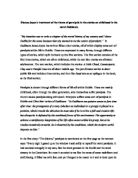In both stories the illusion to the older generation seems to be strongly connected with religion. “Paralysis. I had always sounded strangely in my ears, like the word gnomon.” In The Dubliners religion is often connected with paralysis. This leads me to say that the older generation seem to represent a form of paralysis, especially in The Sisters. In discovering that the boy’s friend, the priest, has died the narrator goes on to say, “I found it strange that neither I nor the day seemed in a mourning mood.” The narrator is being emancipated from the paralysis of religion by the death of this older man. Similarly the boys in An Encounter call the priest at their school “Bunsen Burner” as if relating to his fiery temper. In order to escape him they miss a day of school. In both stories the children run away from the older generation.
The older age group may be put hand in hand with religion by Joyce because they are not as free minded as the younger ones. This is conveyed by Joyce’s constant references to escaping to different lands. In The Sisters the narrator alludes to a dream of Persia and the boys in an An Encounter looked in the dock at the ship which was supposedly a “Norwegian vessel.”
The Main focus of both Joyce’s stories is an older person. In The Sisters it is a priest and in An Encounter it is the man who they meet in the field. Both are shrouded in mystery. This may represent the fact that Joyce finds older people mysterious in their devotion to religion. However, the narrators in the stories experience an affinity with the older character and learn from them, An Encounter shows the narrator being taught about girls by the strange man and eventually at the end of the story realises that along with the older man he too does not like his friend Mahoney. The Sisters tells of a friendship between the priest who has started to loose his religion, “It was that chalice he broke” and a boy. The priest teaches the boy of “the Irish collage in Rome.”
In the first story the other slightly more minor representations of the old generation each represent different parts of life in Dublin, for example Old Cotter’s red nose implies an alcohol problem. “God have mercy on his soul, sad my aunt piously,” the word “piously” symbolizes the harsh life that many Dubliners lived. “The heels of her cloth boots were trodden down all one side,” here is an example of the poverty that existed in Dublin at the time.
The respect towards elders is clear in both stories, for example, in The Sister the narrator says he “pretended to pray.” The fact that he still went through the ritual despite not believing shows he is aware of his requirements. In An Encounter the narrator says that the man, “expressed these sentiments which bored us a little we kept silent.” Again this is proving the same point as highlighted in The Sisters. That even if they do not agree with the elder generation they are willing to listen.
However, in The Sisters foreign lands are an escape but in An Encounter the man that the boys meet is described as having “Bottle green eyes.” Earlier in the story the narrator “examined the foreign sailors to see had any of them green eyes.” It is also explained that Ulysses in The Odyssey has green eyes. The point that the man has green eyes is that he represents foreign lands which are strange and make the boys feel “agitation.” The experience of the older men lead both the boys to their epiphany. In The Sisters that being that in the death of the man the binds of religion have been loosened a little and in An Encounter the boy realises that despite the mans odd ideas about little boys and girls the narrator agrees with the man that he does not like his friend.
Finally, both stories display conflict between the generations. However, a trait similar to both is that the narrator in each story experiences a kinship with an older character. This may be common of Joyce’s childhood section as a way of showing that children are keen to learn and it is the job of those in authority to do this. Taking this into consideration, I believe that as the characters grow up through the book, the relationship between the old and young will start to be assessed from a different angle. In the first two stories in the book opinions are passed on the older generation by the younger ones. In the final stories it will be visa versa.







